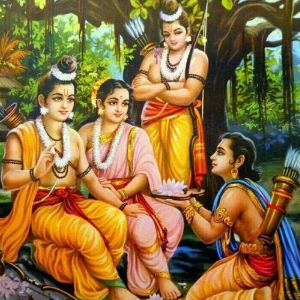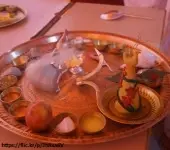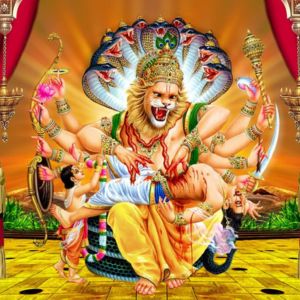This audio tells you about how the Saptarshis were cursed by Mahadeva during Daksha-yaga. They had to go to Janaloka and take rebirth.
What is the meaning of the name Agastya?
Agastya means - one who froze the mountain's growth. Vindhya mountain started growing to block the path of the Sun. Sage Agastya crossed Vindhya from the north towards the south and made the mountain promise not to grow until he returned. अगं विन्ध्यं स्त्यायति इत्यगस्त्यः ।
Quiz
How many rutus are there in a year?Transcript
(Click here to read more)
The Saptarshis are also called Prajapatis, lords of creation. They initiate creation. Creation happens through them also. There are also Prajapatis other than the Saptarshis. But now let's focus on the Saptarshis. The entire creation - sustenance - dissolution of universe is of the duration of 4.32 billion years. This is divided into 14 Manwantaras. Each Manwantara has got 71 Mahayugas in it. Now, we are in the 7th Manwantara from the beginning of the present Kalpa. ....
Transcript
(Click here)
The Saptarshis are also called Prajapatis, lords of creation.
They initiate creation.
Creation happens through them also.
There are also Prajapatis other than the Saptarshis.
But now let's focus on the Saptarshis.
The entire creation - sustenance - dissolution of universe is of the duration of 4.32 billion years.
This is divided into 14 Manwantaras.
Each Manwantara has got 71 Mahayugas in it.
Now, we are in the 7th Manwantara from the beginning of the present Kalpa.
The present Manwantara is called Vaivaswata - Manwantara.
The first Manwantara was Swayambhuva - Manwantara.
In Swayambhuva - Manwantara, Daksha performed a yaga which was eventually destroyed by Mahadeva.
At that time, Mahadeva had cursed the Saptarshis.
They had to go from here and stay in Janaloka.
The Loka called Maha is above Swargaloka and Janaloka is even above that.
Saptarshis can be back only when Vaivaswata - Manwantara comes.
To initiate creation in Swayambhuva - Manwantara, they have to be reborn at the end of the earlier Manwantara that is Cakshusha - Manwantara.
At the end of Chakshusha - Manwantara, Varunadeva conducted a yajna.
He was the yajamana of that yajna.
What is a yajna?
Yajna is the process of creation.
Creation happens through yajna.
Soma is offered in Agni and something new comes out of it.
A third something which was not existing before comes out of it.
Agni is the consumer, soma is the consumed.
Soma is a generic term - it stands for everything that is consumed, like ghee, milk, curd, grains, herbs.
This is what happens in the entire universe, it is said agneeshomeeyam jagat.
This process of consumption is what goes on in everything.
Even in human procreation, ovum is Agni, semen is soma.
At the time of impregnation, semen is offered like an ahuti of ghee in the Agni that is the ovum.
See the color itself; the ovum is red like Agni, semen has the color of ghee.
Human procreation is a yajna.
In Varuna’s yajna, everything has to be created.
We will look at how the Saptarshis were created.
Here Brahma’s retas or semen is the soma, the material that is offered in Agni
.
When Brahma offered the first ahuti, Bhrigu Maharshi came out of Agni.
Brahma called him Bhrigu because he came out breaking open the flames.
Breaking is bhedana in Sanskrit.
Bhrigu from bhedana.
Mahadeva adopted Bhrigu as his son.
The second ahuti, Brahma offered in the embers instead of flames, embers are called angara in Sanskrit.
The Rishi that was born out of this was Angira.
Agnideva adopted him.
Then, Brahma divided his retas, semen into six parts and offered them in Agni.
When the first part was offered, Marichi Maharshi came out from the brilliance, the brilliant rays of Agni.
Marichi means rays in Sanskrit.
That’s how Marichi Maharshi got his name.
The second part gave birth to Kratu Maharshi.
Kratu is a synonym for yajna.
Since he was born from this yajna, he got this name.
When the third part was offered, Atri Maharshi came out declaring - I am the third.
Aham triteeyaha, aham triteeyaha - A from aham and Tri from triteeyaha, The first syllables.
The fourth and fifth, Pulastya and Pulaha were born from kusha grass that were used as prastara in the yajna.
They stand for the hair of the Yajna - purusha.
Pulastya from the horizontal spread and Pulaha from the vertical.
Agni has a synonym - Vasu.
All the dravyas offered in Agni are also called Vasu.
Vasu also means wealth.
Vasishta was born from the middle of Agni in the yajna kunda, hence he was called Vasishta.
So if you see, in Swayambhuva - Manwantara the Rishis were seven.
Now, there are eight: Bhrigu, Angira, Marichi, Kratu, Atri, Pulastya, Pulaha, and Vasishta
Recommended for you
Mantra For Getting Husband's Affection

ॐ नमः सीतापतये रामाय हन हन हुँ फट् । ॐ नमः सीतापतये रामाय �....
Click here to know more..Abhyanga

What is abhyanga? Its medical and religious benefits, when abhyanga should not be done.......
Click here to know more..Narahari Ashtakam

यद्धितं तव भक्तानामस्माकं नृहरे हरे। तदाशु कार्यं कार्�....
Click here to know more..
English Topics
Rare Topics
Click on any topic to open
- 237 The Practice of Bhojana Sadhana
- 236 Words of Wisdom - 2
- 235 Defining Goodness - Sanatana Dharma's Perspective
- 234 Vibhishana in Ramayana - A Tale of Morality, Loyalty, and Redemption
- 233 God will not let you break
- 232 A Glimpse into the 64 Arts
- 231 Chembai Vaidyanatha Bhagavatar - A Carnatic Maestro's Musical Odyssey
- 230 Understanding Adhyāsa: A Closer Look at False Attribution
- 229 Is Family's Permission Necessary For Becoming Sanyasi ?
- 228 Faith In Upasana
Please wait while the audio list loads..
30
Ganapathy
Shiva
Hanuman
Devi
Vishnu Sahasranama
Mahabharatam
Practical Wisdom
Yoga Vasishta
Vedas
Rituals
Rare Topics
Devi Mahatmyam
Glory of Venkatesha
Shani Mahatmya
Story of Sri Yantra
Rudram Explained
Atharva Sheersha
Sri Suktam
Kathopanishad
Ramayana
Mystique
Mantra Shastra
Bharat Matha
Bhagavatam
Astrology
Temples
Spiritual books
Purana Stories
Festivals
Sages and Saints
